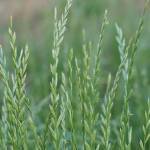Ryegrass Staggers in Horses

Perennial ryegrass (Lolium perenne) is a cool-season grass that establishes readily in most soils due largely to the vigor of seedlings. Mature plants produce excellent forage for horses and other livestock in terms of yield. When infected with the endophytic fungus Neotyphodium lolii, however, perennial ryegrass can be problematic, even dangerous, for horses.
The endophyte, which lives in the plant’s cells, produces a mycotoxin known as lolitrem B, a potent neurotransmitter inhibitor. (Interestingly, the word “lolitrem” is a combination of the Latin genus “Lolium” and the word “tremor.”+) Once absorbed into the bloodstream, lolitrem B induces clinical signs such as muscle tremors, incoordination, and other neurological impairments, including a slow, wobbly gait. When viewed from a distance, affected horses may appear normal. Nevertheless, when the animals are stressed or spooked into action, clinical signs become obvious.
In a study that evaluated the clinical expression of lolitrem B intoxication in horses, researchers found that horses experienced ataxia and tremors of varying degrees, including subtle, rapid involuntary movements of the eyeball. Blindfolding exacerbated ataxia characterized most notably by a “drunken sailor” gait, including asymmetrical steps with uncertain stops and starts. In horses most severely intoxicated, researchers documented limb edema, heel lesions, and copious nasal discharge.*
While no effective treatment has been developed, horses generally recover a few days after being removed from endophyte-infected perennial ryegrass. Horses rarely die of ryegrass staggers but sometimes succumb because of their inability to stand, which leaves them unable to eat or drink.
Significant concentrations of lolitrem B occur in the plants during late summer and fall, making diagnosis of toxicity in these seasons most common. Lolitrem B concentrates at the base of the plant. As pastures are grazed down late in the growing season, horses may nip at plants near the ground, thus ingesting more toxin than they would if grazing longer swards.
Horse owners can take some precautionary steps when it comes to avoiding ryegrass staggers.
- Identify the grasses and other plants that grow in paddocks and fields. Consult with an agronomist or forage expert if you have trouble classifying certain plants. This is also an ideal time to scope out weeds or poisonous plants that may be gaining a foothold in a grazing area.
- Maintain leafy swards whenever possible and resist overgrazing perennial ryegrass. Mow grass before seedheads form, as endophyte is spread only by seed.
- Remove horses from perennial ryegrass at times when concentrations of lolitrem B may be elevated, during slow-growing periods or when the grass has been grazed to stubble.
- Check horses daily to ensure they move normally when encouraged to do so. If any single horse exhibits unsteady gait, remove all horses from the paddock as quietly as possible to limit stress, which intensifies clinical signs. Place them in a grazing area without perennial ryegrass or in an enclosure with hay. Hay harvested from infected stands may cause the same clinical signs. Call a veterinarian immediately.
- Remain vigilant around affected horses. Many are unsteady on their feet with a propensity to fall, potentially causing harm to their handlers.
- Consider overseeding with other pasture plants during pasture renovation. If seedheads are not allowed to form on perennial ryegrass, less of it may appear in the pasture as other grasses gain dominance. Renovating a pasture in one full swoop is an extremely difficult undertaking and the cost likely substantial, so incremental improvements may be necessary. Expert advice in pasture management should be sought.
+Gallagher, R.T., E.P. White, and P. H. Mortimer. 1981. Ryegrass staggers: Isolation of potent neurotoxins lolitrem A and lolitrem B from staggers-producing pastures. New Zealand Veterinary Journal 10:189-190.
*Johnstone, L.K., I.G. Mayhew, and L.R. Fletcher. 2011. Clinical expression of lolitrem B (perennial ryegrass) intoxication in horses. Equine Veterinary Journal 44:304-309.
Di Menna, M.E., S.C. Finch, A.J. Popay, and B.L. Smith. 2012. A review of Neotyphodium lolii/Lolium perenne symbiosis and its associated effects on animal and plant health, with particular emphasis on ryegrass staggers. New Zealand Veterinary Journal 60:315-328.








